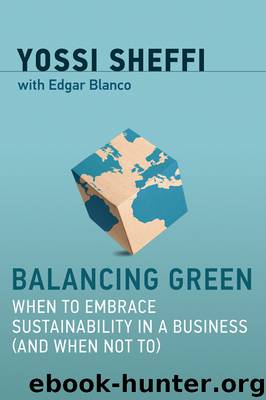Balancing Green by Yossi Sheffi

Author:Yossi Sheffi
Language: eng
Format: epub
Tags: corporate sustainability; supply chains; management; strategy; procurement; manufacturing; delivery; design; marketing; economic growth; Patagonia; Seventh Generation; Dr. Bronner's Magical Soap
Publisher: The MIT Press
Published: 2018-04-02T04:00:00+00:00
8 Green by Design
Paraphrasing George Bernard Shaw, Senator Robert Kennedy said: “Some men see things as they are and say ‘Why?’ I dream things that never were and say ‘Why not?’”1 Moving from incremental sustainability initiatives to ones that create substantial reductions in environmental impacts requires changing the products themselves, and it sometimes involves far-reaching changes. It requires changing elements of the design such as the types of materials, the amounts of materials, and the manufacturing technologies. “Designers are the start of everything, and if we can educate the designer to make better choices, then they can become agents of change for the entire industry,” said Hannah Jones, vice president of sustainable business and innovation at Nike.2 Design and engineering with the environment in mind can lead to reduced impacts caused by sourcing, manufacturing, use, and disposal of the product.
Design, by its very nature, involves trade-offs among competing objectives such as costs, product features, product performance, quality, and manufacturability.3 Starting at the end of the 20th century, many product designers and engineers were challenged with an additional objective: curbing environmental impacts by reducing material footprint, emissions, waste, and toxins. The goal is to “eliminate negative environmental impact completely through skillful, sensitive design,” according to Jason McLennan, author of The Philosophy of Sustainable Design.4
These added goals may also involve trade-offs, even between different sustainability objectives, let alone conflicting with other business objectives. A new bioplastic might reduce the carbon footprint of making a product but increase waste if that plastic cannot be recycled. A new, more efficient car might go farther on a gallon of gas and spew fewer emissions but require sourcing higher-environmental footprint alloys that consume more energy during manufacturing. Eliminating a potentially toxic ingredient from a detergent might diminish cleaning performance and cause consumers to use more hot water or more of the product itself to achieve the same level of cleanliness.
Download
This site does not store any files on its server. We only index and link to content provided by other sites. Please contact the content providers to delete copyright contents if any and email us, we'll remove relevant links or contents immediately.
| Anthropology | Archaeology |
| Philosophy | Politics & Government |
| Social Sciences | Sociology |
| Women's Studies |
The Secret History by Donna Tartt(18151)
The Social Justice Warrior Handbook by Lisa De Pasquale(11950)
Thirteen Reasons Why by Jay Asher(8447)
This Is How You Lose Her by Junot Diaz(6430)
Weapons of Math Destruction by Cathy O'Neil(5825)
Zero to One by Peter Thiel(5487)
Beartown by Fredrik Backman(5348)
The Myth of the Strong Leader by Archie Brown(5236)
The Fire Next Time by James Baldwin(5015)
How Democracies Die by Steven Levitsky & Daniel Ziblatt(4950)
Promise Me, Dad by Joe Biden(4907)
Stone's Rules by Roger Stone(4852)
100 Deadly Skills by Clint Emerson(4684)
A Higher Loyalty: Truth, Lies, and Leadership by James Comey(4546)
Rise and Kill First by Ronen Bergman(4542)
Secrecy World by Jake Bernstein(4387)
The David Icke Guide to the Global Conspiracy (and how to end it) by David Icke(4376)
The Farm by Tom Rob Smith(4320)
The Doomsday Machine by Daniel Ellsberg(4241)
